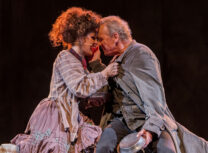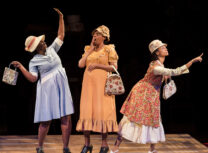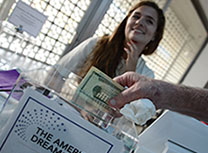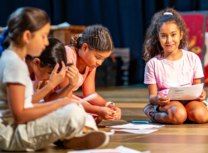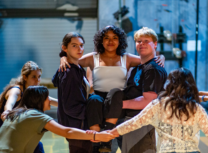Storytelling Workshop
Who: Students grades 5 and up, led by ANW Theatre Artists.
What: A one-time workshop held at the students’ school. Students work with ANW’s Teaching Artists to engage with the text in a deeper way and enhance the experience of seeing the live production. Your workshop can be conducted before or after your students attend the show.
Objectives: Through storytelling, theatre aims to inspire the audience to think more deeply about themselves, society, and the world. Students will learn techniques that help them convey the story with their bodies, voices, and imaginations, while gaining a deeper appreciation for the power of storytelling.
Focus Questions
- What are tactics? How do we convey meaning and intention non-verbally/physically?
- Importance of Voice: Shakespeare uses the power of language – and so, an actor must use his language actively and expressively to drive the play.
- Importance of Movement: In Shakespeare’s work, movement plays an important role in telling the story. The rhyme, rhythm and physical movement are what are combined to bring Shakespeare’s text to life.
- Importance of Tactics: Tactics are those devices we use to aid ourselves when going after our objectives. So, for example, if the objective is, “I wish to gain my lover’s consent,” the actor can choose “to flatter,” “to threaten,” “to annoy.” These verbs are the helpers to the success of attaining your objective.
Workshop Breakdown
Warm-up (10 minutes)
- Instructors will introduce themselves to the students.
- VOCAL AND PHYSICAL WARM UP (5 minutes)
- The vocal and physical warm-up activity will allow the students to wake up and prepare themselves for the activity, but also show them the importance of exercising their voices, focusing on enunciation, articulation, projection and volume.
- LEAD WITH…Activity (5 minutes)
- Students will be asked to walk around the space by “leading” with various body parts: pinky, left elbow, right hip, etc. They will be asked to walk around the space leading with that part of the body. They will be asked to allow this to influence the other parts of the body: hands, feet, legs, etc.
- Students will allow their physicality to create a character they feel would move in this way.
- Students will be asked to interact with other students in character.
The development of this activity will connect to the overall lesson focus, which shows how important it is to be connected to one’s body in performance, how one positions one’s character can affect a scene’s interpretation, meaning, pace, etc.
Activity 1 (20 minutes)
- Students will be given a scene to work on.
- Students will break into groups and read the scene(s).
- They will discuss as a group what the scene means and how they can use their bodies to explain the story. After discussing the context, the roles will be assigned.
- Students will “perform” the scene using only their bodies, no words!
- 3-4 groups will share for the group.
- Discuss:
- How can intention be conveyed physically? What did the students notice? The students and the teachers will begin to note the importance of communication, using your voice, and telling the story.
Activity 2 (25 minutes)
- Students will discuss tactics in a given scene.
- Students work to identify the tactics characters use. They consider how our understanding of these helps us to interpret what motivates a character at any given moment in the play. Working on tactics helps students to focus on the language of Shakespeare and to identify how the words a character speaks work to produce their desired outcome.
- Students will break into groups and work on the scene incorporating specific vocal and physical choices based on their interpretation of the text. Students will be encouraged to choose EXTREME tactics to explore the scene in that way.
- Students will collaborate with another group where one group will serve as the “director” and the other group will serve as the “performer.” Directors will help specify moments that could be changed or enhance the overall choices made. Once groups have discussed and analyzed the first scene, they will switch roles.
- Everyone will come together and 3-4 groups will share their scenes with everyone.
- The students will begin to recognize how important it is to convey meaning, both verbally and physically.
Reflection (5 minutes)
- Instructors will explain why this activity is useful (provide examples), how all professional actors still rely on classic storytelling techniques to enhance their work.
- Examples: Spending time with their script, Breaking up the text through Objectives, Tactics, Obstacles, etc.
- Examples: Finding new ways to verbalize and physicalize a scene by using new tactics and ideas.
- Example: Beginning, Middle, End, Hero’s Journey
- Questions/Closure
